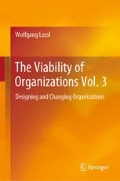Abstract
This chapter focuses on the design of the (basic) systems 1, i.e., the operational processes. It discusses the key elements that need to be considered in a design process, namely the environmental variety, the eigen-variety, and the operational processes. From there, it shows how, by temporalizing the VSM, it can be related to business process maps—an aspect especially insightful to VSM experts.
Access this chapter
Tax calculation will be finalised at checkout
Purchases are for personal use only
Notes
- 1.
All figures in this chapter related to the VSM are or contain and if not stated otherwise, adapted (detail) views from Beer (1995b), p. 136, Fig. 37.
- 2.
The tendency to overfulfill can sometimes result rather from of uncertainty and risk aversion instead of real customer needs.
- 3.
How are the metasystemic functions present during these customer interactions? To minimize the physical presence of a manager, organizations use formal rules, regulations and handbooks. The salesperson then does not need to ask a manager in person. The metasystem or system 1 management is then not present through a person but through these regulations, handbooks and instructions.
References
Beer, S. (1995a). The heart of enterprise. Managerial cybernetics of organization: Vol. 2. Chichester [England], New York: Wiley. (Figures 21, 51 and 86 republished with permission of John Wiley and Sons Inc. and the permission conveyed through the Copyright Clearance Center, Inc.).
Beer, S. (1995b). Diagnosing the system for organizations. The managerial cybernetics of organization. Chichester [West Sussex], New York: Wiley. (Figures 21, 25 and 37 republished with permission of John Wiley and Sons Inc. and the permission conveyed through the Copyright Clearance Center, Inc.).
Boudreau, J. W. (1998). Strategic human resource management measures: Key linkages and the people vantage model. Journal of Human Resource Costing & Accounting,3(2), 21–40. https://doi.org/10.1108/eb029046.
Boudreau, J. W. (2008). The new science of human capital. Harvard Business Review Press. Retrieved from https://hbr.org/ideacast/2008/01/harvard-business-ideacast-76-t.html.
Boudreau, J. W., & Ramstad, P. M. (2007). Beyond HR: The new science of human capital. Harvard Business Review Press.
Cascio, W. F., & Boudreau, J. W. (2012). Short introduction to strategic human resource management. Cambridge short introductions to management. Cambridge: Cambridge University Press.
Disney Enterprises. (2003). Be our guest: Perfecting the art of customer service (1st pbk. ed). New York: Disney Editions.
Drucker, P. F. (2006). The effective executive: The definitive guide to getting the right things done. Harper Colophon books. New York: Collins.
Eye Witness to History. (2018). Immigration in the early 1900s. Retrieved from http://www.eyewitnesstohistory.com/snpim1.htm.
Kinni, T. B. (2011). Be our guest: Perfecting the art of customer service (Rev. and updated ed). New York: Disney Editions.
Shuit, D. (2004). Magic for sale. Retrieved from www.workforce.com/2004/09/03/magic-for-sale/.
Author information
Authors and Affiliations
Corresponding author
Rights and permissions
Copyright information
© 2020 Springer Nature Switzerland AG
About this chapter
Cite this chapter
Lassl, W. (2020). The “Interior Design” (Part 1): Finding and Defining the Way to Generate Benefits and Purpose. In: The Viability of Organizations Vol. 3. Springer, Cham. https://doi.org/10.1007/978-3-030-25854-2_11
Download citation
DOI: https://doi.org/10.1007/978-3-030-25854-2_11
Published:
Publisher Name: Springer, Cham
Print ISBN: 978-3-030-25853-5
Online ISBN: 978-3-030-25854-2
eBook Packages: Business and ManagementBusiness and Management (R0)

